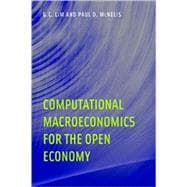
Note: Supplemental materials are not guaranteed with Rental or Used book purchases.
Purchase Benefits
Looking to rent a book? Rent Computational Macroeconomics for the Open Economy [ISBN: 9780262123068] for the semester, quarter, and short term or search our site for other textbooks by Lim, G. C.; McNelis, Paul D.. Renting a textbook can save you up to 90% from the cost of buying.
| Preface | p. xi |
| Acknowledgments | p. xv |
| Introduction | p. 1 |
| The Open Economy Setting | p. 1 |
| Solution Methods | p. 3 |
| Policy Goals, Welfare, and Scenarios | p. 13 |
| Plan of the Book | p. 15 |
| Computational Exercises | p. 17 |
| A Small Open Economy Model | p. 19 |
| Introduction | p. 19 |
| Flexible Price Model | p. 20 |
| Solution: Projection Method | p. 28 |
| Stochastic Dynamic Simulations | p. 32 |
| Effects of a Demand Shock | p. 39 |
| Concluding Remarks | p. 43 |
| Computational Exercise: Stochastic Processes | p. 43 |
| Sticky Domestic Prices | p. 47 |
| Introduction | p. 47 |
| Model with Calvo Pricing | p. 49 |
| Computational Analysis | p. 53 |
| Stochastic Simulations | p. 56 |
| Output Gaps and Sensitivity Analysis | p. 62 |
| Concluding Remarks | p. 65 |
| Computational Exercise: Output in the Taylor Rule | p. 66 |
| Income and Consumption Taxes | p. 69 |
| Introduction | p. 69 |
| Model with Taxes | p. 71 |
| Model Solution | p. 74 |
| Stochastic Simulations | p. 75 |
| Scenario Analysis | p. 79 |
| Concluding Remarks | p. 82 |
| Computational Exercise: Model Validation with VARs | p. 83 |
| Current Account Dynamics | p. 85 |
| Introduction | p. 85 |
| Model with Endogenous Exports | p. 86 |
| Computational Analysis | p. 90 |
| Productivity Shocks | p. 91 |
| Scenario Analysis | p. 94 |
| Concluding Remarks | p. 98 |
| Computational Exercise: Real Exchange-Rate Volatility | p. 100 |
| Capital and Tobin's Q | p. 103 |
| Introduction | p. 103 |
| Model with Capital Accumulation | p. 105 |
| Solution Algorithm | p. 109 |
| Stochastic Dynamic Simulations | p. 113 |
| Scenario Analysis-Q Targeting | p. 114 |
| Concluding Remarks | p. 117 |
| Computational Exercise: Risk and Q growth | p. 119 |
| Economy with Natural Resources | p. 121 |
| Introduction | p. 121 |
| Two-Sector Model | p. 122 |
| Solution Algorithm | p. 127 |
| Simulation Analysis | p. 128 |
| Terms-of-Trade Shocks | p. 132 |
| Concluding Remarks | p. 134 |
| Computational Exercise: Real Exchange Cross-Correlations | p. 135 |
| Financial Frictions | p. 139 |
| Introduction | p. 139 |
| DSGE Model with Banking | p. 140 |
| Solution Algorithm | p. 147 |
| Simulation Analysis | p. 149 |
| Scenario Analysis | p. 152 |
| Concluding Remarks | p. 152 |
| Computational Exercise: The "Great Moderation" | p. 153 |
| Wage Rigidities | p. 157 |
| Introduction | p. 157 |
| Model with Sticky Wages | p. 158 |
| Solution Algorithm | p. 164 |
| Simulation Analysis | p. 165 |
| Sensitivity Analysis | p. 168 |
| Concluding Remarks | p. 170 |
| Computational Exercise: Dunlop-Tarshis Puzzle | p. 171 |
| Habit Persistence | p. 173 |
| A DSGE Model with Habit Persistence | p. 174 |
| Solution Algorithm | p. 180 |
| Stochastic Simulations | p. 181 |
| Simulating Alternative Scenarios | p. 185 |
| Concluding Remarks | p. 187 |
| Computational Exercise: Output and Interest Rate | p. 188 |
| International Capital Flows and Adjustment | p. 191 |
| Capital Reversals | p. 192 |
| Continuing Inflows | p. 194 |
| Future Research | p. 196 |
| Appendixes | |
| Definition of Symbols | p. 201 |
| Definition of Variables | p. 203 |
| The Computer Algorithm | p. 205 |
| Notes | p. 211 |
| Bibliography | p. 215 |
| Index | p. 225 |
| Table of Contents provided by Publisher. All Rights Reserved. |
The New copy of this book will include any supplemental materials advertised. Please check the title of the book to determine if it should include any access cards, study guides, lab manuals, CDs, etc.
The Used, Rental and eBook copies of this book are not guaranteed to include any supplemental materials. Typically, only the book itself is included. This is true even if the title states it includes any access cards, study guides, lab manuals, CDs, etc.